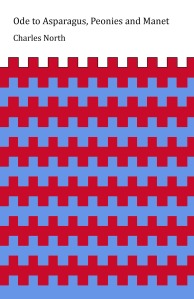Ode to Asparagus, Peonies and Manet by Charles North
If you find yourself in the Musée d’Orsay in Paris someday with only ten minutes to spare, you might steer yourself to the rather small, very unassuming still-life that Charles North calls “poignant, mysteriously beautiful.” It is a single asparagus spear, lying flush on the edge of a table, awash in strokes of green and cream.
Asparagus (1880) was originally a charming thank you from Manet to a buyer who overpaid for the painting that preceded it, Bunch of Asparagus (1880). The latter, a vigorously brushed group of asparagus spears bound by twine, is another of North’s favorites, with its “rich color,” “variety of strokes,” and “wonderful overlappings and bedragglings.” He writes in Ode to Asparagus, Peonies and Manet that the spears are “brushed to display planes, depths, lights and shadow; in their awkward confinement, they burst with life.”
Only a few pages in length, North’s Ode reads like a love letter to unconventionality. It isn’t the luscious still-life melon of Monet that North likes, or Chardin’s brioche, or Vermeer’s skulls, which are all masterful, uncanny paintings, presumably less beguiling in their realness. North writes:
When Manet began showing, he was mocked not only for his indoor nudes, but for what and how he didn’t paint, his obvious interest in painted surfaces and brushstrokes per se, the gestural, “unfinished” nature of his images, his lack of interest in conventional beauty, the radical simplification of his approach. George Bataille (who in his critical book on Manet titles one chapter “The Destruction of the Subject”) quotes the contemporary critic Duranty from as late as 1870: “At any exhibition, even from many rooms away, there is only one painting that stands out from the rest: It’s a Manet every time. One is apt to laugh, for the effect is queer when a single thing differs from all the others.”
There’s something about Manet being “mocked” for what and how he didn’t paint that is admirable in our day; work that varies so vividly from one’s contemporaries is often the one that ultimately feels the most authentic, or at least the most alluring. North, whose series of baseball-inspired “Lineups” in the 1970s were both innovative and controversial, might have a soft spot for the nonconformist. I like Manet’s Asparagus, too. The single spear he sent to Charles Ephrussi after the buyer overpaid for the original painting hints at his playful sense of humor and spontaneousness, the asparagus’s awkward placement on the canvas mysterious and suggestive.
North’s Ode also rhapsodizes over the still-life images Manet embedded into his other works, such as the bowl of blood oranges (or mandarins or nectarines) to the right of the blankly staring barmaid in Bar at the Folies-Bergére (1882) and the “dog-earned,” “minty green” book underneath a “gratuitous wood stool” in Portrait of Theodore Duret (1868). These included still-lifes are striking, North writes, perhaps because the paintings are not supposed to be about them.
“Of course we’re drawn to small things in paintings by other painters too,” he says. “But there’s something about objects and Manet, early, middle and late; and it’s there in these paintings as much as in his official still-lifes.”
What is that something? North wouldn’t go so far as to say Manet is the best still-life painter in history, or even necessarily his favorite still-life painter, but the words he uses to describe these objects indicates an interest in the beauty hidden behind all that appears unseemly. Words such as: unfussy, unpretty, straightforward, disorderly, awkward, nothing pretty about it, no concessions to the viewer, forlorn-looking, disfigurement, unconventional, messy, and a clump. And yet? The paintings are also: enthralling, extraordinary, lovely, wonderful, poignant, stunningly radiant, ravishingly beautiful, vibrant, and lovely. Adjectives such as “wonderful” and “awkward” are used multiple times and often together. And if still-lifes are supposed to capture reality, isn’t that how reality is really like? The one can hardly exist without the other.
North ends his Ode with a note about the lesser known watercolor sketches that Manet often drew in the margins of letters sent to friends, mostly in 1880. These sketches, some decorative and others relevant to the content of the notes, are of various objects: apples, almonds, cats, a watering can, flowers and flags. “Where the flowers (especially) compete for space with the writing (occasionally making words difficult to read),” North writes, “it seems clear that they were at least as important to Manet as the message; to us clearly more so.”
Download Ode to Asparagus, Peonies and Manet for free at The Song Cave
Emily Ann Buckler is an MFA candidate at Stony Brook Manhattan. She lives in Brooklyn.
